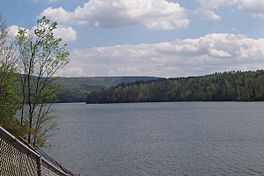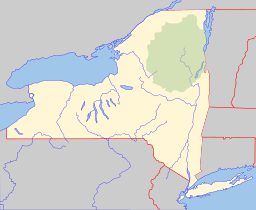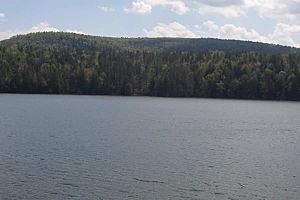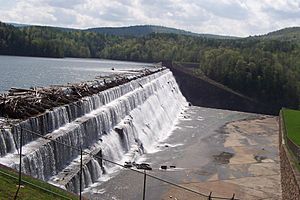Schoharie Reservoir facts for kids
Quick facts for kids Schoharie Reservoir |
|
|---|---|
 |
|
| Location | Catskill Mountains, Schoharie / Delaware / Greene counties, New York, United States |
| Coordinates | 42°22′16″N 74°26′23″W / 42.3712°N 74.4398°W |
| Type | Reservoir |
| Primary inflows | Schoharie Creek |
| Primary outflows | Schoharie Creek |
| Basin countries | United States |
The Schoharie Reservoir is a large reservoir located in the Catskill Mountains of New York State. It was built to be one of the many reservoirs that provide New York City with its drinking water. This reservoir was created by building a dam across the Schoharie Creek. Parts of the reservoir are located in different counties: Schoharie County (in the towns of Conesville and Gilboa), Delaware County (in Roxbury), and Greene County (in Prattsville).
Contents
Building the Schoharie Reservoir
New York City needed more water as its population grew. Even after the Ashokan Reservoir and Kensico Reservoir were built, there still wasn't enough water. So, officials started looking for a new location.
They found the village of Gilboa, New York. The city bought the land, and the people living there had to move out. Workers then cleared most of the trees and buildings in the area.
The dam for the reservoir was built in the early 1920s using stone bricks. The area was flooded in 1924, and the reservoir started providing water in 1926. The village of Gilboa was moved to a new spot nearby. If there is a drought and the water level drops, you can sometimes still see traces of the old village.
Where the Reservoir is Located
The Schoharie Reservoir is the northernmost reservoir in New York City's water system. It is about 36 miles (58 km) southwest of Albany. It is also roughly 110 miles (180 km) northwest of New York City.
The reservoir is located where three counties meet: the southern part of Schoharie County, the northeastern part of Delaware County, and the northwestern part of Greene County. Nearby towns include Gilboa, Prattsville, and Conesville. The reservoir is a part of the Schoharie Creek, which flows into the Mohawk River. The Mohawk River then flows into the Hudson River.
How the Reservoir Works
The Schoharie Reservoir is one long basin, about 6 miles (9.6 km) long. It can hold about 17.6 billion US gallons (66.6 billion liters) of water when full. This makes it one of the smaller reservoirs that supply New York City.
Since 1926, the Schoharie Reservoir has provided about 15-16 percent of the water needed by nine million people each year. It is one of two main reservoirs in the Catskill Water System, along with the Ashokan Reservoir. When the Schoharie Reservoir overflows, water goes over the Gilboa Dam and back into Schoharie Creek. This water eventually flows into the Hudson River.
Water from the Schoharie Reservoir travels to New York City through a long tunnel called the Shandaken Tunnel. This tunnel is 16 miles (26 km) long. The water then empties into the Esopus Creek near Shandaken. About 11 miles (18 km) further down, the Esopus Creek flows into the Ashokan Reservoir. From there, the water enters the 92-mile (147 km) Catskill Aqueduct. This aqueduct carries the water to the Kensico Reservoir and then on to New York City.
The Gilboa Dam
The Gilboa Dam is 120 feet (37 m) high and made of concrete and stone bricks. It was finished in 1926. Over time, parts of the dam started to wear away. This meant it could become a danger to people living downstream.
In December 2005, the New York City Department of Environmental Protection started a $24 million project to make the dam safer. Starting in December 2006, they installed 80 strong cables. These cables were drilled through the dam and into the solid rock below. This work helped the dam meet New York State safety rules. Some local residents noticed their tap water turned brownish during this time. This might have been because of the drilling.
Schoharie County also set up a warning system for the Gilboa Dam. This system has 20 sirens that stretch from the Town of Gilboa to the Town of Esperance. New York City paid for this system.
A bigger project to fix the Gilboa Dam started in the summer of 2011. This project was estimated to cost $350 million. It will make the dam much stronger and add floodgates. It will also include a large tunnel that can release water safely from the reservoir into Schoharie Creek. A group of citizens called Dam Concerned Citizens, Inc. was formed to watch the dam's safety. They want to make sure people living downstream are safe.
Dam Safety During Storms
On August 28, 2011, Hurricane Irene brought a lot of rain, up to 12 inches (30 cm), to the area. Even though the dam was still strong, officials told people living downstream to leave their homes. This included mandatory evacuations for the towns of Middleburgh and Schoharie. The evacuation was because of the heavy rain, not because the dam had failed.
After a small earthquake on August 27, 2011, and another larger one in Virginia that was felt far away, New York Governor Andrew Cuomo ordered checks on important structures like the Gilboa Dam. Governor Cuomo visited the dam on August 28, 2011. He reported that officials found no damage to the dam from the recent earthquakes.





